.
Stephen Lawrence murder: Dobson and Norris found guilty
The Stephen Lawrence murder trial boiled down to three things; blood, fibres and hair. These tiny fragments of new evidence emerged in 2007 as scientists conducted a massive "cold case review". They re-examined clothing taken from the two defendants, Gary Dobson and David Norris, starting a process that eventually led to a guilty verdict for both men. The prosecution had argued that these microscopic clues linked the defendants to the murder. But Tim Roberts QC, for Gary Dobson told the court: "The actual evidence upon which this charge is brought, the fibres and fragments, would not fill a teaspoon."
-
- Gary Dobson
- Bomber jacket
- Cardigan
- Blood stain
- Evidence bag
- Fibre tapings
- Fibre tapings
- Stephen Lawrence
- Cardigan
- Polo shirt
- Jacket
-
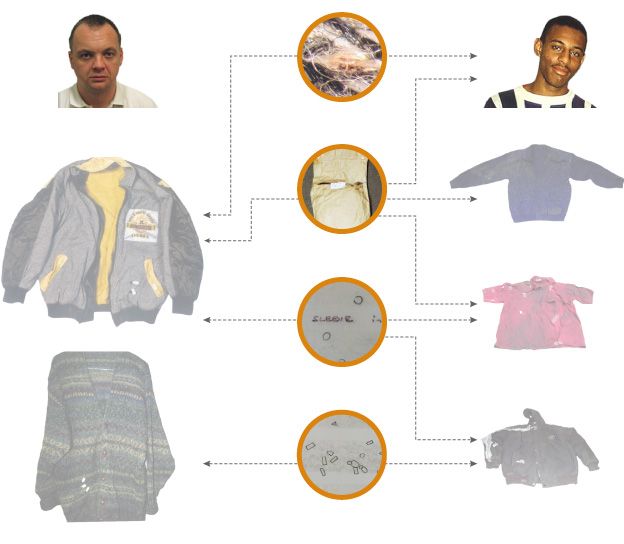
Introduction
Click on a circle to find out moreThe bomber jacket and cardigan pictured on the left were taken from Gary Dobson's home two weeks after the killing of Stephen Lawrence in 1993.
Connected to them were several fibres and some tiny flakes of blood that proved central to the case - click on the circles to find out more.
Alan Tribe, of the Metropolitan Police, explains how they set about the Stephen Lawrence cold case review.
-
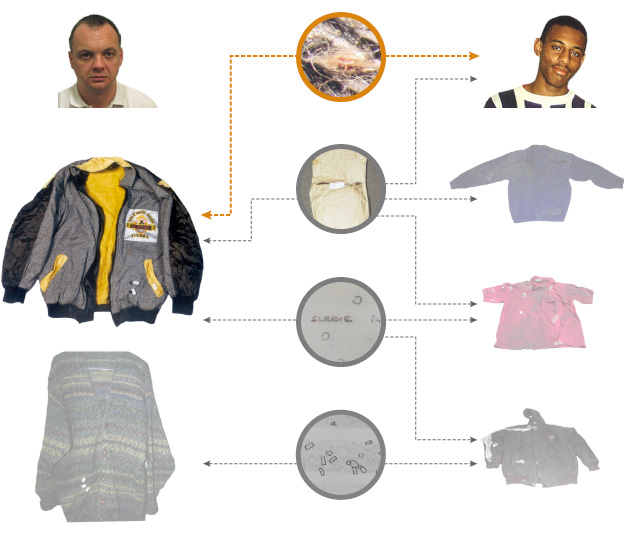
Blood stain on the bomber jacket
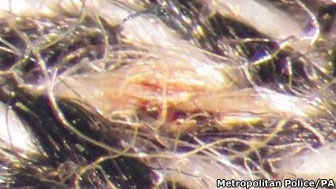
The blood stain dried into the weave of the bomber jacket's collar was the most significant finding of the case review in 2007. The jury was told that there was less than a billion-to-one-chance that the DNA was not that of Stephen Lawrence.
The tiny stain measured 0.5mm x 0.25mm and was only uncovered after the jacket had been examined with a microscope. The prosecution argued it placed the wearer of the bomber jacket at the scene of the crime because such a tiny amount of blood would dry very quickly.
Forensic scientist Edward Jarman found the stain after two days of work with a microscope. He told the trial: "There was a potential that the blood could be transferred by the weapon itself when removed from the victim or [be] the actual blood from the injury itself."
The defence said that the blood stain could have been caused by a dried blood flake dissolving during tests for saliva. Mr Jarman told the court he had conducted experiments to test this theory - but he never achieved a similar stain.
Speaking during the trial, Gary Dobson's mother, Pauline, said her son had not worn the jacket for several years.
-
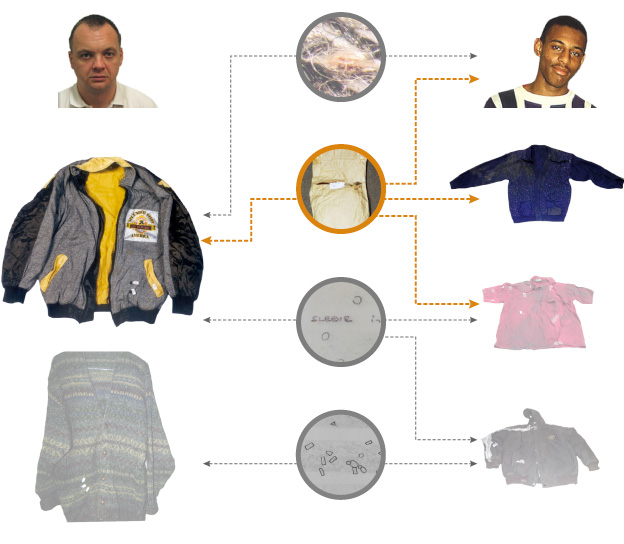
The contents of the evidence bag

After its seizure from Gary Dobson's home the bomber jacket was kept in an evidence bag for safe keeping. Tiny particles left in the bag were examined by forensic scientists and blood flakes were found.
One piece of dried blood matched Stephen Lawrence's DNA, while another piece encased fibres that had a high probability of matching Stephen's cardigan, argued the prosecution.
The scientists said these dried blood flakes were important in leading them to the collar stain.In addition, a fibre matching those in Stephen's polo shirt was also found in the evidence bag debris. The defence said the evidence could have been contaminated over the years because bags were either improperly sealed - or the seals themselves had failed.
Edward Jarman, Lead Scientist at LGC Forensics, explains how he found blood on exhibits that provided a match for Stephen Lawrence's DNA.
-
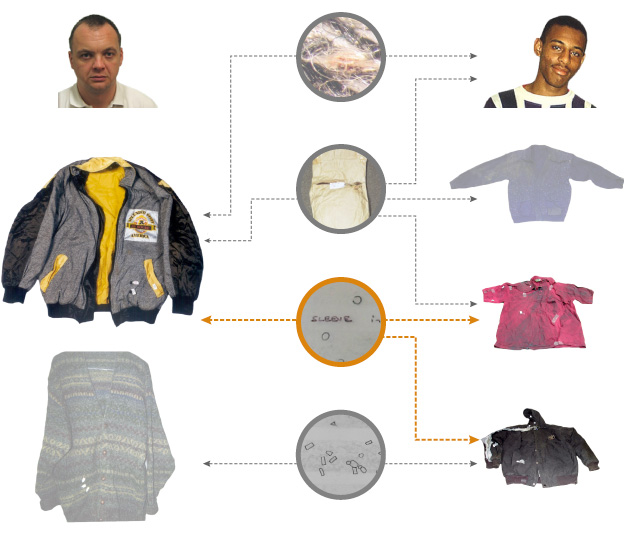
Fibres found on the bomber jacket
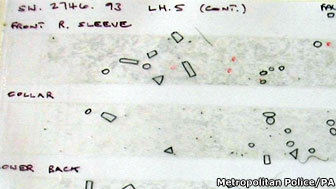
Samples of fibres, collected using adhesive tape, were taken during the original murder investigation. These tapings were re-examined during the case review and fibres matching Stephen's jacket and polo shirt were found.
Ros Hammond, the scientist responsible for assessing possible contamination, said it would require "truly remarkable" events to occur for the collection of fibres and other exhibits to be the result of contamination.
But the defence argued that as Stephen was wearing many layers of clothing it was implausible that fibres from the polo shirt would have been available for transfer during his attack.
Ros Hammond of LGC Forensics tells how it was important to "counter any suggestion of contamination"
-
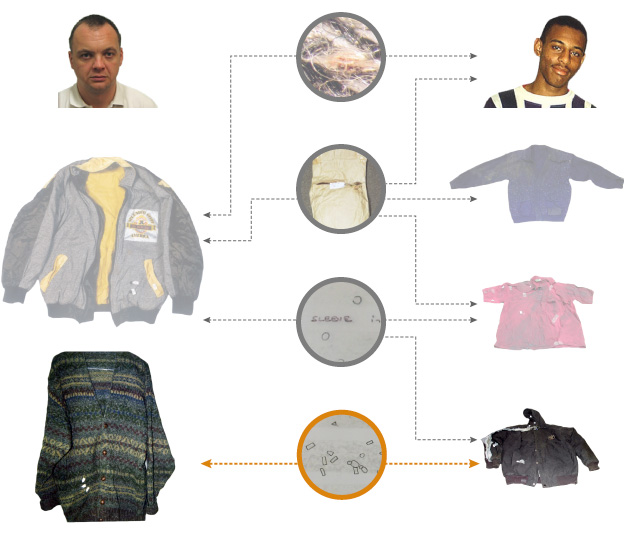
Fibres found on the cardigan
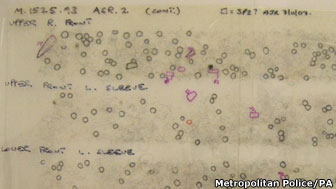
A cardigan was taken by police from Gary Dobson's home. Tapings were made from it which uncovered blue-green acrylic fibres that matched the cuff and wristband of Stephen's jacket. Scientists concluded that they were significant and strong evidence of a link.
There were other tests of fibres found on tapings of Stephen's clothing. While the fibres appeared indistinguishable to some of those in the cardigan, the prosecution did not rely on this as evidence because the fibres were more common and could have come from elsewhere.
During defence evidence, the jury heard that the old cardigan was not something that Gary Dobson would have worn - it was kept by the family for gardening and decorating.
-
- David Norris
- Trousers
- Sweatshirt
- Evidence bag
- Fibre tapings
- Stephen Lawrence
- Polo shirt
- Trousers
-
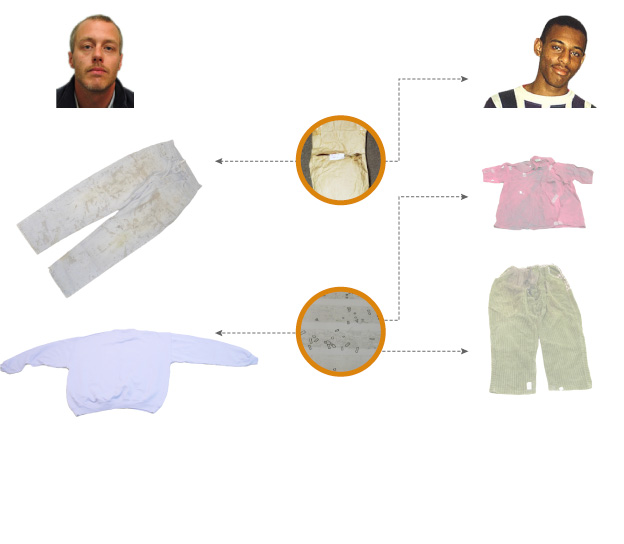
Introduction
Click on a circle to find out moreThe jeans and sweatshirt pictured on the left were taken by police from David Norris's home two weeks after Stephen was killed. The evidence against him, presented during the trial, surrounded hairs and fibres found amongst these items of clothing. Click on the circles to find out more. -

Evidence bag

The jeans, covered in varnish and paint stains, were examined for blood and none was found. But the forensic scientists found two small hairs in the evidence bag that had held the jeans.
One hair was 1mm in length and the second was 2mm in length. The longer hair was tested for a mitochondrial DNA match with Stephen. MtDNA is only passed down through the maternal line. It does not provide a full profile of an individual, but is a very powerful scientific tool, often used to investigate family ties.
A geneticist examined MtDNA databases and told the court the chance of it not coming from Stephen was one in 1,000. The cold case team that found the evidence say that the hair was "close to the limit" of what could be examined for DNA.
When asked about the jeans in court David Norris said he didn't recognise them as his - the waist was two inches smaller than his size.
-

Fibres found on the sweatshirt
Seven fibres were found on the sweatshirt that had a match to fibres from Stephen Lawrence's clothes. Six of them matched fibres from Stephen's green trousers, while a single fibre matched fibres in his red polo shirt.
David Norris maintained in court that the sweatshirt did not belong to him and that he had had nothing to do with Stephen Lawrence's death.
The pictures above are all exhibits that featured in the trial's scientific evidence. But the specific image of the bag that held Gary Dobson's jacket and the fibre tapings from David Norris' clothes were not available. Similar images from the investigation have been used for illustration.
~RS~q~RS~~RS~z~RS~07~RS~)

 MPs warn on growth of UK jihadists
MPs warn on growth of UK jihadists